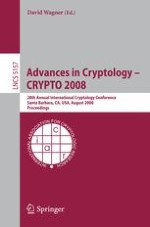This book constitutes the refereed proceedings of the 28th Annual International Cryptology Conference, CRYPTO 2008, held in Santa Barbara, CA, USA in August 2008. The 32 revised full papers presented were carefully reviewed and selected from 184 submissions. Addressing all current foundational, theoretical and research aspects of cryptology, cryptography, and cryptanalysis as well as advanced applications, the papers are organized in topical sections on random oracles, applications, public-key crypto, hash functions, cryptanalysis, multiparty computation, privacy, zero knowledge, and oblivious transfer.
